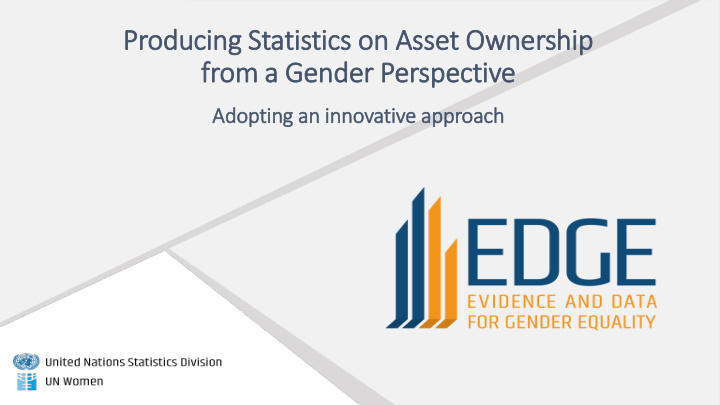



Producing Statistics on Asset Ownership fr from a Gender Perspective Adopting an in innovative approach
Why collecting asset ownership data from a gender perspective is important? Women’s ownership and control of assets has long been recognized as a key element of women’s empowerment, also associated with: • Improved food security, child nutrition and education; • Reduction in vulnerability when household dissolves; • Increased bargaining power However, very little information is available 1. Broader definition of asset ownership 2. From household-level ownership to individual-level ownership 3. From proxy to self-reported respondent 4. Gender lens integrated into each step of data collection (sample selection, interview protocol, gender matching, etc.) 5. Indicators responding to a variety of gender relevant policy questions 2
From ownership to bundle of ownership rights Bundle of ownership Reported Documented Right to Right to sell bequeath ownership ownership rights Self- Alienation perception rights
Why a bundle of ownership rights? Percentage of reported owners of principal dwelling who also report:
From household to individual • From proxy to self-reporting Proxy: Self-report: she owns... I own... • Sampling individual(s) within household, with sufficient number of • Women and men as individuals • Couples: intra-couple analysis
Proxy vs self-report Percentage point increase in prevalence of asset ownership, by sex, when data is self-reported (not proxied) Percentage point Percentage point Sex of respondent increase, increase, reported Country owner reported ownership of ownership of principal dwelling agricultural land Men 2 7 Georgia Women 4 3 Men 10 [n.a.] Mongolia Women 5 [n.a.] Men 7 [n.a.] Philippines (Cavite Province) Women 6 [n.a.] Men 11 10 Uganda Women 14 5
Intra-household gender analysis Providing evidence on Gender wealth gap many gender issues Gender asset gap
Measuring the gender asset gap Distribution of reported principal dwelling owners, by sex of owners, Uganda, 2014 Prevalence of reported ownership of the Share of women among owners of the principal principal dwelling dwelling Source: EDGE pilot surveys
Measuring the gender wealth gap Mean values of principal dwelling owned by women and men, Mongolia (2015) and Uganda (2014) Mean values of principal Prevalence of reported dwelling among owners with ownership (per cent) 95% confidence interval Women Men Women Men Principal dwelling Uganda 35 60 7.7 13.1 Mongolia 30 53 33.5 32.9 Source: EDGE pilot surveys Note: for illustration purpose only, data are not comparable across countries
Intra-household analysis Ownership of assets within a couple 100% 90% 80% 70% 60% 50% 40% Average� sizse� of� agricultural� land� owned 3 2.3 30% 20% 2 1 10% 1 0% Mexico rural, agricultural Mongolia, principal Uganda, agricultural land 0 land dwelling Wife Husband Both own Only wife owns Only husband owns Neither spouse owned Source: EDGE pilot surveys Note: for illustration purpose only, data are not comparable across countries
• Testing of concepts and methods: • Should the list/roster of assets be collected at Other the household or individual level? innovations • How often do people hide their assets from others? • How important is gender matching between the interviewer and respondent? • How feasible are simultaneous interviews? • Providing a basket of options for NSOs • Strong support from countries and partners in testing different methodologies Appending Appending Stand- alone a module Minimum survey set of Sustainability/usability of questions methods proposed
Thanks https://unstats.un.org/edge
Recommend
More recommend